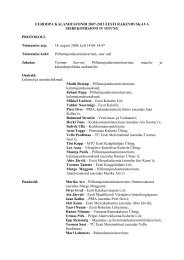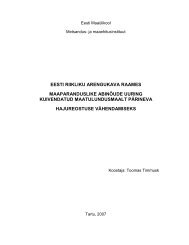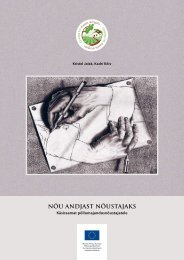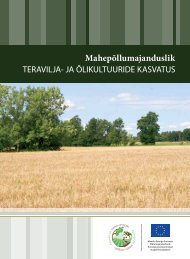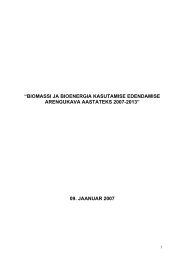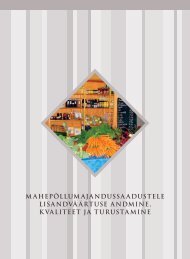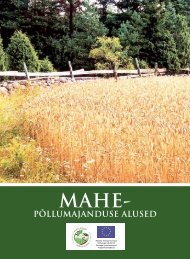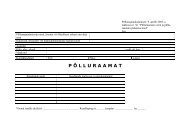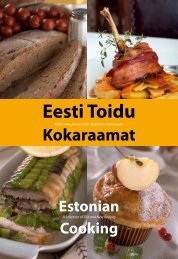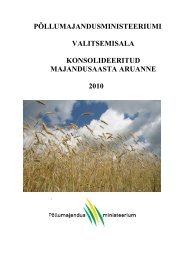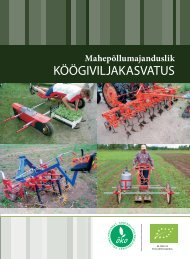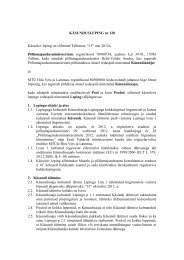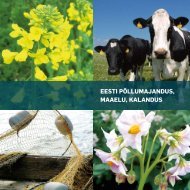estonian agriculture, rural economy and food industry
estonian agriculture, rural economy and food industry
estonian agriculture, rural economy and food industry
Create successful ePaper yourself
Turn your PDF publications into a flip-book with our unique Google optimized e-Paper software.
4.<br />
in ownership relations, a situation has emerged in<br />
Estonia where one owner can own 2 to 15 or even<br />
more separate parcels of l<strong>and</strong>; however, it is very<br />
difficult to make economic use of the l<strong>and</strong>.<br />
In 2000, reconstruction projects for 185 ha of<br />
polders <strong>and</strong> 118 ha of sprinkled areas were prepared<br />
in cooperation between the Estonian company<br />
PB Maa ja Vesi <strong>and</strong> the Finnish company<br />
Salaojakeskus Ry.<br />
Until 1995, l<strong>and</strong> improvement systems were<br />
included in the balance sheets of the local l<strong>and</strong><br />
amelioration bureaux. In the course of l<strong>and</strong> restitution,<br />
l<strong>and</strong> improvement systems that were located<br />
on the l<strong>and</strong>s of owners, were granted to the<br />
owners free of charge. Twenty-two per cent of the<br />
drainage systems had been transferred to l<strong>and</strong><br />
owners by the end of 2000.<br />
It is more benificial for l<strong>and</strong> owners to manage<br />
the l<strong>and</strong> improvement systems collectively as a<br />
single system can cover the l<strong>and</strong>s of several owners.<br />
The first l<strong>and</strong> <strong>and</strong> water association (LWA) was<br />
founded in 1993. Since 1995, the state has supported<br />
the foundation <strong>and</strong> activities of LWAs. One<br />
hundred LWAs had been registered by the end of<br />
2000. For improved efficiency, local unions <strong>and</strong> a<br />
Federation of L<strong>and</strong> <strong>and</strong> Water Association have<br />
been established.<br />
Another problem of Estonian <strong>agriculture</strong> is the<br />
acidity of soils. The estimated area of soils in need<br />
of liming is 200,000–300,000 ha. Acidic soils need<br />
to be limed every five years. In the prices of 2000,<br />
the liming of one hectare cost 800–2,500 kroons.<br />
The state supports liming of soils in an average<br />
amount of 14–17 million EEK a year.<br />
Transition to a market <strong>economy</strong><br />
changed the structure of livestock<br />
farming<br />
The reduction in the total livestock production in<br />
1993–1999 was greater than the reduction in total<br />
plant production. Due to transitioning to new market<br />
conditions, the relative share of <strong>agriculture</strong> decreased<br />
<strong>and</strong> brought about structural changes in livestock<br />
production. The changes are also reflected in domestic<br />
<strong>and</strong> foreign dem<strong>and</strong> for <strong>food</strong>stuff (Table 5).<br />
The number of sheep <strong>and</strong> goats <strong>and</strong> the number<br />
of bovine animals have decreased the most<br />
over the last ten years: 78% <strong>and</strong> 65% respectively.<br />
The negative effect is also apparent in l<strong>and</strong><br />
use: Pastures <strong>and</strong> grassl<strong>and</strong>s have fallen out of<br />
use; they are covered with weeds <strong>and</strong> will<br />
eventually overgrow with bushes.<br />
Dairy farming is the main source<br />
of income for agricultural holdings<br />
Dairy farming is the main source of income for<br />
agricultural holdings despite the fact that the total<br />
yield of milk has decreased 1.6 times in the last ten<br />
years. The total milk yield in the year 2000 was<br />
629,000 t (1,093,000 t in 1991) (Figure 2).<br />
The total milk yield has decreased due to the<br />
decrease in the number of bovine animals;<br />
however, yields per cow have increased since 1994<br />
<strong>and</strong> continue to grow.<br />
Yields per cow are improving partly due to the<br />
remaining herds consisting of the best performing<br />
cattle <strong>and</strong> milk producers having started paying<br />
more attention to balanced feed rations <strong>and</strong> to the<br />
quality of feedstuff, particularly silage production.<br />
TABLE 5.<br />
1991<br />
1992<br />
1993<br />
1994<br />
1995<br />
1996<br />
1997<br />
1998<br />
1999<br />
2000<br />
(Source: ESO)<br />
FIGURE 2.<br />
'000 tonnes<br />
Bovines<br />
708,3<br />
614,6<br />
463,2<br />
419,5<br />
370,4<br />
343,0<br />
325,6<br />
307,5<br />
267,3<br />
252,8<br />
Number of animals as of 31 December ('000)<br />
Pigs<br />
798,6<br />
541,1<br />
424,3<br />
459,8<br />
448,8<br />
298,4<br />
306,3<br />
326,4<br />
285,7<br />
300,2<br />
1400<br />
1200<br />
1000<br />
800<br />
600<br />
400<br />
200<br />
0<br />
1990 1991 1992 1993 1994 1995 1996 1997 1998 1999 2000<br />
Milk ('000 t)<br />
Sheep <strong>and</strong> goats<br />
142,8<br />
124,2<br />
83,3<br />
61,5<br />
49,8<br />
39,2<br />
35,6<br />
30,8<br />
30,9<br />
32,2<br />
Horses<br />
7,8<br />
6,6<br />
5,2<br />
5,0<br />
4,6<br />
4,2<br />
4,2<br />
3,9<br />
3,9<br />
4,2<br />
Yield per cow (kg/year)<br />
Poultry<br />
5 538,3<br />
3 418,1<br />
3 226,1<br />
3 129,7<br />
2 911,3<br />
2 324,9<br />
2 602,0<br />
2 635,7<br />
2 461,8<br />
2366,4<br />
5250<br />
4500<br />
3750<br />
3000<br />
2250<br />
1500<br />
750<br />
0<br />
kg/year<br />
17



